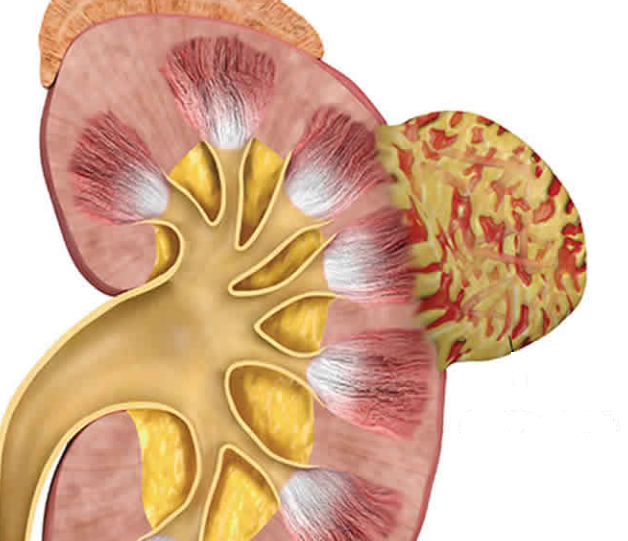Index
Introduction
Amidst a myriad of medical conditions and diseases, there are some that, though less renowned, have a profound impact on the lives of the affected individuals. Angiomyolipoma is one such condition. This article aims to provide a comprehensive overview of angiomyolipoma, shedding light on its causes, symptoms, and available treatment options.
What is Angiomyolipoma?
Angiomyolipoma is a benign, that is, non-cancerous tumor, most commonly found in the kidneys, though it can appear in other parts of the body. Comprising a mixture of blood vessels, smooth muscles, and fatty tissue, it’s generally asymptomatic. However, it can pose significant issues if it enlarges or ruptures.
Prevalence of Angiomyolipoma
Though angiomyolipoma is deemed a rare condition, its prevalence is noteworthy, affecting approximately 0.3% to 3% of the general population. There’s a higher incidence in women and it is frequently diagnosed in patients around the age of 40. Nonetheless, it’s vital to note that these tumors can occur in individuals of all ages, genders, and medical backgrounds.
Importance of Knowledge about Angiomyolipoma
As they are usually symptom-free, angiomyolipomas are often incidentally diagnosed during imaging tests done for other reasons. Once an angiomyolipoma is identified, it’s crucial to monitor the tumor’s growth to prevent complications, like renal hemorrhage, which can be potentially fatal.
Furthermore, being informed about angiomyolipoma is essential for both patients and healthcare professionals. For patients, understanding the disease can aid them in making informed decisions about their treatment and care. For doctors, familiarity with the condition and its features facilitates accurate diagnosis and effective treatment.
Angiomyolipoma and Tuberous Sclerosis Syndrome
It’s pertinent to emphasize that angiomyolipoma is associated with Tuberous Sclerosis Syndrome (TSC), a rare genetic condition that causes benign tumors in various organs of the body. It’s estimated that up to 80% of patients with TSC develop angiomyolipomas. Therefore, being knowledgeable about this condition might be a pivotal step for the proper diagnosis and treatment of angiomyolipoma.
Throughout this article, we will delve deeply into the nature of angiomyolipoma, the reasons behind its occurrence, the symptoms that might emerge, and the treatment options presently available. The aim is to elucidate this medical condition, broadening awareness and knowledge to assist both healthcare professionals and patients.
What is Angiomyolipoma?
Angiomyolipoma is a complex, albeit benign, medical condition that can bring with it a series of implications for the patient’s health. Fully understanding what angiomyolipoma is, where it typically occurs, and who is most likely to be affected is crucial for proper diagnosis and treatment.
Nature of Angiomyolipoma
Angiomyolipoma is a benign tumor, which means it is non-cancerous. It is composed of a mix of three different types of tissue: blood vessels (angioma), smooth muscle (myoma), and fat (lipoma). The presence of these three distinct tissues gives angiomyolipoma its unique characteristics, setting it apart from other medical conditions.
Common Location of Angiomyolipoma
Although angiomyolipoma can technically occur anywhere in the body, it is most commonly found in the kidneys. Renal angiomyolipomas are often incidentally discovered during imaging tests conducted for other reasons, due to the typically asymptomatic nature of these tumors. However, if they grow in size, they can cause uncomfortable symptoms and serious complications.
Who is Affected by Angiomyolipoma?
In terms of who is most likely to be affected by angiomyolipoma, the condition has a higher prevalence in women and is typically diagnosed in patients in their 40s. However, it’s important to emphasize that angiomyolipomas can occur in individuals of all ages, genders, and medical backgrounds.
Sporadic Angiomyolipoma and TSC-associated
There are two main forms of angiomyolipoma: sporadic and associated with Tuberous Sclerosis Syndrome (TSC). Sporadic angiomyolipoma is the more common type, occurring without any apparent connection to another medical condition. On the other hand, TSC-associated angiomyolipoma occurs in patients who have this rare genetic condition, which causes benign tumors in various organs of the body.
Size and Growth of Angiomyolipoma
The size of an angiomyolipoma can vary significantly, from small tumors of just a few centimeters to larger tumors that can reach several centimeters in diameter. Most angiomyolipomas grow slowly, but some can experience rapid growth and become symptomatic, causing pain and other issues. In rare cases, angiomyolipomas can rupture, leading to internal bleeding that requires immediate medical attention.
Causes of Angiomyolipoma
The exact origin and cause of angiomyolipoma remain subjects of research and debate within the medical community. However, there are some theories and potential risk factors that might contribute to the development of this condition.
Sporadic Angiomyolipoma
In the case of sporadic angiomyolipoma, which is the most common type, the precise cause remains unknown. Some studies suggest that random genetic changes may play a role in the development of these tumors. Nevertheless, the research is still inconclusive, and further studies are needed to confirm this hypothesis.
Angiomyolipoma and Tuberous Sclerosis Syndrome
On the other hand, for angiomyolipoma associated with Tuberous Sclerosis Syndrome (TSC), the cause is well-established. TSC is a genetic disorder, resulting from mutations in the TSC1 or TSC2 genes. These genes are responsible for producing proteins that suppress tumor growth, helping to prevent uncontrolled cell growth. When there’s a mutation in one of these genes, it can lead to the development of benign tumors in different parts of the body, including renal angiomyolipoma.
Risk Factors for Angiomyolipoma
Although the exact causes of angiomyolipoma are not fully elucidated, there are some risk factors that seem to be associated with this condition. As previously mentioned, being female and being around the age of 40 are risk factors for angiomyolipoma. Additionally, having Tuberous Sclerosis Syndrome significantly increases the risk of developing angiomyolipomas.
Future Research on the Causes of Angiomyolipoma
Understanding the causes of angiomyolipoma is crucial for the development of more effective prevention and treatment strategies. For this reason, ongoing research is required to explore potential causes and underlying mechanisms of angiomyolipoma. This investigation will not only provide valuable insights for doctors and researchers but may also lead to significant advancements in the care and treatment of patients with angiomyolipoma.
Symptoms of Angiomyolipoma
The symptoms of angiomyolipoma can vary depending on various factors, such as the size of the tumor and its location. In many cases, angiomyolipoma is asymptomatic, meaning it doesn’t cause noticeable symptoms. However, when symptoms do occur, they can be quite distinct and require immediate medical attention.
Asymptomatic Angiomyolipoma
It’s important to note that many angiomyolipomas are asymptomatic, especially when they are small. They are often accidentally discovered during imaging tests for other medical conditions. This is one of the reasons why it’s crucial to undergo regular medical check-ups, particularly if you belong to a risk group for developing angiomyolipomas.
Common Symptoms of Angiomyolipoma
When angiomyolipoma symptoms do occur, they are generally the result of tumors that have grown large enough to press on surrounding tissues or organs. These symptoms may include pain in the lower back or the side of the body (renal pain), a noticeable lump in the kidney area, and blood in the urine (hematuria).
In rare cases, an angiomyolipoma might rupture, leading to serious internal bleeding. This can cause symptoms such as sudden and intense abdominal pain, weakness, dizziness, and in severe cases, shock. This is a medical emergency that requires immediate attention.
Angiomyolipoma and Symptoms of Tuberous Sclerosis Syndrome
For those with angiomyolipoma associated with Tuberous Sclerosis Syndrome (TSC), the symptoms of angiomyolipoma might coexist with TSC symptoms. These can include white spots on the skin, seizures, developmental delays, and behavioral and cognitive problems.
Importance of Early Diagnosis
Early identification of angiomyolipoma symptoms is crucial for preventing complications and starting treatment as soon as possible. If you experience any of the mentioned symptoms, it’s important to seek medical attention immediately. While the presence of these symptoms doesn’t necessarily mean you have an angiomyolipoma, they should be investigated to determine the underlying cause.
Diagnosis of Angiomyolipoma
The diagnosis of angiomyolipoma is a multifaceted process that involves a combination of clinical assessment, medical history, physical examinations, and imaging tests. Let’s delve into how these techniques are employed in diagnosing angiomyolipoma.
Clinical Assessment and Medical History
The first step in diagnosing angiomyolipoma is a comprehensive clinical evaluation and a review of the patient’s medical history. The doctor will inquire about any symptoms the patient is experiencing, as well as any family history of angiomyolipoma or Tuberous Sclerosis Syndrome. This can aid the doctor in determining if the patient has an elevated risk of developing angiomyolipomas.
Physical Examinations
The doctor may also conduct a physical examination. While angiomyolipomas may not be palpable during a routine physical check-up, the physician can look for signs of complications, such as abdominal pain or signs of shock in the case of a ruptured angiomyolipoma.
Imaging Tests
The primary diagnostic method for angiomyolipoma is the use of imaging tests, such as ultrasound, computed tomography (CT), and magnetic resonance imaging (MRI). These tests allow the doctor to visualize the kidney and pinpoint the presence of tumors.
- Ultrasound: This is often the initial test conducted since it’s non-invasive and radiation-free. Ultrasound can identify the presence of tumors but might not be able to distinctly distinguish angiomyolipoma from other types of renal tumors.
- Computed Tomography (CT): CT provides a more detailed view of the kidney and can assist in pinpointing angiomyolipomas more accurately. A contrast dye may be injected into the patient to enhance the tumor’s visibility during the scan.
- Magnetic Resonance Imaging (MRI): MRI is typically reserved for cases where the results from ultrasound and CT are inconclusive. MRI offers even more detailed images and can be particularly useful in visualizing complex angiomyolipomas.
Biopsy
In certain cases, when imaging test results are inconclusive, a biopsy may be needed. During a biopsy, a small tissue sample is taken from the tumor for laboratory analysis. However, biopsies are seldom used in diagnosing angiomyolipoma due to the risk of bleeding.
Next, we will discuss the available treatment options for angiomyolipoma, which depend on several factors, including the size of the tumor and the patient’s symptoms.
Treatments for Angiomyolipoma
The treatment for angiomyolipoma is determined by a range of factors, including the size of the tumor, the patient’s symptoms, the patient’s overall health, and the presence of any complications, such as bleeding. In this section, we’ll delve into the primary treatment approaches for angiomyolipoma.
Active Monitoring
For small and asymptomatic angiomyolipomas, the most common treatment approach is active monitoring. This involves regular imaging tests to track the tumor’s size and growth. Active monitoring is often preferred for smaller tumors, as the risk of surgical complications may outweigh the risk posed by the angiomyolipoma.
Embolization
Embolization is a minimally invasive procedure that involves blocking blood flow to the angiomyolipoma. During this procedure, a catheter is inserted into a blood vessel and guided to the vessel feeding the angiomyolipoma. An embolic substance is then released to block the vessel, causing the tumor tissue to die due to lack of blood supply.
Radiofrequency Ablation or Cryotherapy
Radiofrequency ablation and cryotherapy are minimally invasive techniques that destroy angiomyolipoma tissue. Radiofrequency ablation uses radio waves to generate heat and destroy tumor tissue, while cryotherapy employs extremely low temperatures to the same end.
Surgery
Surgery may be required in cases where the angiomyolipoma is large, growing quickly, causing significant symptoms, or at risk of rupture. Several surgical techniques may be utilized, depending on the patient’s specific circumstances:
- Partial Nephrectomy: This procedure involves removing only the tumor and a small portion of the surrounding kidney tissue. It’s preferred whenever possible to preserve kidney function.
- Radical Nephrectomy: This is the complete removal of the kidney and is usually reserved for cases where the tumor is very large or the kidney is severely damaged.
- Laparoscopic or Robotic Nephrectomy: These are minimally invasive procedures using small incisions and specialized tools to remove the tumor. They offer the advantage of shorter recovery times and less post-operative pain.
Medicinal Therapies
In certain instances, especially when the angiomyolipoma is associated with Tuberous Sclerosis Syndrome, medications like mTOR inhibitors might be prescribed. These medications help reduce the tumor’s size and manage symptoms.
Choosing the treatment for angiomyolipoma is a decision to be made jointly by the patient and their medical team, considering the benefits and risks of each option. This decision should factor in the size and location of the angiomyolipoma, the patient’s age and overall health, symptoms, and the patient’s tolerance to specific procedures or medications.
It’s vital to highlight that although angiomyolipoma can be a daunting condition, most angiomyolipomas are benign and can be effectively managed with a combination of active monitoring and intervention when necessary.
Conclusion
Throughout this article, we have examined the medical condition known as angiomyolipoma, addressing what it is, who is most likely to be affected, its causes, symptoms, diagnosis, and treatment options.
Angiomyolipoma is a rare benign tumor that primarily occurs in the kidneys and is composed of a mix of blood vessels, smooth muscles, and fat. Although most angiomyolipomas are asymptomatic and incidentally discovered during imaging tests for other health issues, they have the potential to cause serious complications, such as bleeding, if they grow significantly.
The Role of Awareness and Prevention
Awareness of conditions like angiomyolipoma is crucial. While there isn’t a known way to prevent this condition, understanding potential signs and symptoms can assist in early detection. It’s essential to remember that, though back pain and the presence of blood in the urine can be symptoms of many conditions, including some that are very common, they can also indicate the presence of an angiomyolipoma.
The Importance of Proper Diagnosis and Treatment
Diagnosing angiomyolipoma typically involves a combination of imaging tests, like ultrasound, computed tomography, or magnetic resonance imaging. Treatment, on the other hand, depends on several factors, including the size of the tumor, presented symptoms, and the patient’s overall health. Treatment options range from active monitoring to minimally invasive procedures like embolization, and in some cases, surgery.
Medical Care and Consultation
If you or someone you know is experiencing symptoms that could be attributed to angiomyolipoma, it’s essential to seek medical care. While the condition can be daunting, it’s crucial to remember that most angiomyolipomas are benign and can be effectively managed with appropriate treatment.
In summary, angiomyolipoma is a condition that can have significant repercussions if not properly addressed. Awareness, symptom recognition, accurate diagnosis, and proper treatment are, therefore, of utmost importance. We hope this article has provided a comprehensive and useful insight into the condition, allowing for greater understanding and responsiveness in the face of this medical condition.




